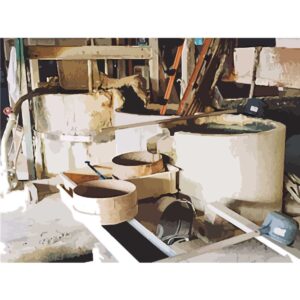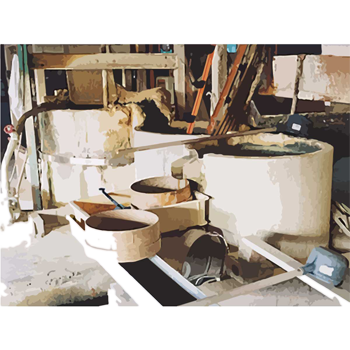
water and fountain solution
This is the process of separating fine and coarse clay by using the buoyancy of water to make up clay.
The water-sieving process is not applicable to any raw materials for ceramics, but is generally limited to kaolin and plastic clays, and the process is omitted for porcelain, fine rubbers, pottery, and terra-cotta.
The method of water-sieving is not always the same, as an appropriate method should be established according to the natural production state of the clay or the type of product, etc. However, the following three steps should be taken regardless of which method is followed.
(i) Throwing crushed clay into the water to control it.
(2) Separating gravel or other coarse grains contained in the clay.
(iii) Plaster of the separated fine grains is allowed to stand and the clay content is gradually deposited.
It seems that it is still impossible to say for certain when the water weir process began in Japan.
According to the “Bessho Kibei: A Record of Suiatsuki” (Bessho Kibei: A Record of Suiatsuki), the first Fujishiro of Seto City used silk to strain rice clay from Ibe’s rice field, and according to popular belief, the clay used for tea containers was first used under the direction of Kobori Enshu.
However, neither of these theories seems to be worthy of belief.
My own theory
It is thought that the water-blotting technique was introduced to Japan with the naturalization of the Korean potters. The method of separating the clay for the body and the glaze stone for the overglaze by water-sieving was introduced, making it possible to use white overglaze, which had never been used before. First in Karatsu, and then in Mino (Shino), white transparent glaze came to be used in Japan, where only ash or iron glaze had been used before.
The arrival of Korean potters introduced continental ceramic manufacturing techniques. The overglaze glaze, as well as the clay, was produced from the same potter’s clay. Although feldspar, the raw material for glaze, is produced today, there was no concept of feldspar at that time (around 1600), and it is thought that clay and glaze were produced from the same clay by water-sieving.
The upper layer is used for clay because of its high kaolin content, the middle layer is used for glaze because of its high silica content, and the lower layer is ground again and re-sieved because of its large particles.
The technique that came from the continent includes the Chinese millstone, which plays another important role in addition to the water-sieving process.
The technique of using a Chinese mortar to grind the clay into fine particles and then separating the clay and glaze by water-blotting is a major point of innovation.



